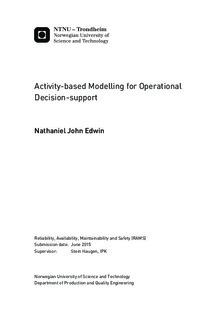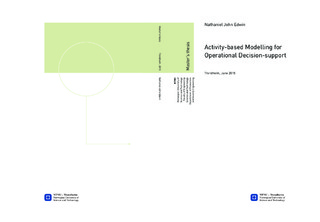| dc.description.abstract | The recent plunge in oil and gas prices has led to most players in the industry cutting capital investments and squeezing operational costs. In such a business setting, increasing production while improving safety performance is a challenge. The Norwegian Petroleum Safety Authority, over the years, has emphasized the importance and relevance of using risk analysis as decision support during all phases of the lifecycle of a facility. The traditional Quantitative Risk Analysis is useful for developing safe design, but during operations its relevance is limited. Therefore the focus has been to develop suitable risk analysis tools to support decisions on a day-to-day operational context.
Existing operational risk analysis methods are broadly grouped into two categories first which provides an updated average risk level and the second a dynamic real-time risk level. The latter has been the area of focus in the recent past and most industry players have developed their own proprietary tools for the same. These are typically software solutions that support integrated management of safety critical information through visualization solutions and better data management. They provide a coarse qualitative overview of the current conditions on a facility, but do not provide any quantitative decision support. An interpretative literature review of existing methods in operational risk analysis from the oil and gas industry reveals that much is left to be done to gain insight into short-term changes in risk levels, also known as risk transients. The few existing methods that provide quantitative real-time operational decision support are limited in coverage and applicability.
To bridge this gap, activity-based modelling is suggested as an approach to measure these transient risk levels in operations. The basic unit of the activity-based operational risk analysis framework is a Risk Influencing Factor (RIF). To support systematic RIF identification for work activities, a hierarchical tree breakdown of an activity is suggested, to support understanding of the relevant hazards, hazardous events, accident scenarios and controls in place for a particular activity. One of the key takeaways from this study is the need to distinguish between risk increasing activities and conditions .
To develop a suitable method to model degradation in barrier condition due to risk increasing activities, a set of existing and relevant models from literature are reviewed. Various features from each of these models are adapted to develop the suggested method. As activities are characterized by the interaction of technical, operational and organizational factors Bayesian Belief Networks (BBNs) are the best available method to reasonably model these factors and their interrelationships. The developed model quantifies barrier condition on a scale from A to F and formally treats uncertainty in RIF measurements and interaction effects between RIFs. The interaction modelling method suggested is an advancement from the original adapted technique from the literature.
To demonstrate the applicability of the model, the BBN is implemented in software and two case scenarios are simulated. The simulations highlight the importance of accurately modelling interaction effects between factors. Using sensitivity analysis, risk reducing measures can be easily identified.
Discussions on the model s relevance and applicability, highlights the need to develop an extended risk model for it to be relevant to decision-makers. This involves understanding and mathematically accounting for synergies and interactions not only between individual factors, but also between individual activities themselves. A coarse idea to integrate this into a unified full-fledged risk model is introduced and identified as an area of further work. Furthermore, if an alternate BBN structure is required to better represent the real-world, this can be done while retaining the mathematical concepts such as uncertainties, interactions etc. as discussed in the thesis. | |

